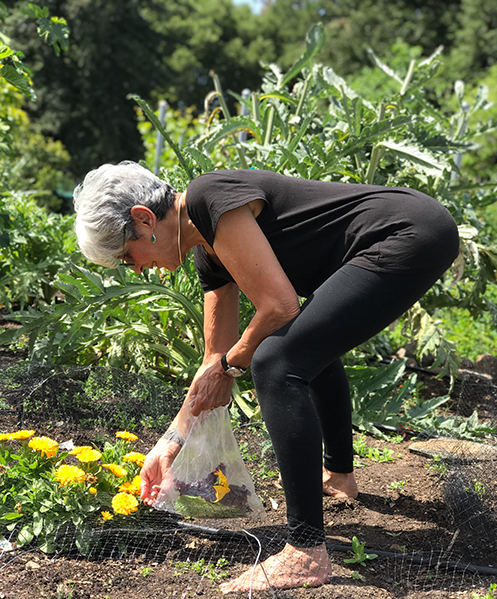Discovering we have osteopenia or osteoporosis can come as a surprise, but our best bet is to focus on where we can make positive changes.
Here are a few places to look.
1. Check your vitamin D. Hopefully, your doctor has been monitoring this, but if not, they’ll be testing it now because one of vitamin D’s jobs is to help our bodies absorb calcium. If it’s low, you’ll need a supplement, a bit more sun, or both.
2. Ensure there’s enough calcium in your diet. Calcium is stored in our bones, and if we don’t have enough for the various bodily tasks that need it (e.g. muscle, heart, blood and nerve function) the reservoir in our bones gets drawn down.
After menopause it’s recommended that we get around 1300mg a day, which is quite a bit.
Jean Hailes for Women’s Health is a national not-for-profit women’s health organisation. Its website lists the amount of calcium in various calcium-rich foods, which gives an indication of how intentional we need to be about getting enough. https://www.jeanhailes.org.au/health-a-z/healthy-living/nutrients/calcium
That site also includes high-calcium recipes. https://www.jeanhailes.org.au/recipes?filters=Calcium-rich
On the dairy front, studies have shown better results with cultured foods such as cheese and yoghurt than with milk. That might be because the bacteria in cultured or fermented foods is good for the gut, and evidence is mounting that gut bacteria play a role in improving bone formation and reducing bone loss.
Cheeses are also a source of vitamin K2, which works together with calcium and vitamin D.
If you think you’ll struggle to include enough calcium in your diet, make an appointment with a dietitian. Especially if you’re vegan or don’t eat dairy, it can take some working out. Whole foods are better absorbed than supplements, and they provide a range of nutrients besides calcium, but if you need a supplement, it’s wise to get advice on the best options.
On the flipside, sugar and other processed food is detrimental to bone. If this is something you’re having a hard time managing, it could be another reason to see a dietitian.
3. Monitor your dietary protein too because bones and muscle need it for growth and repair. It’s handy that high calcium foods such as dairy, sardines and salmon, almonds and tofu are also good sources of protein. But there are lots of other sources, both animal and plant-based. The recommended protein intake to maintain our muscle after menopause is 1-1.5 g per kilogram of body weight, and the most effective way to do that is to include protein at every meal.
4. Watch your posture. In our culture, sitting, standing and bending with a rounded spine has become normal, especially now that our lives revolve around phones, tablets and laptops. We see people bent over these all the time. But if our vertebrae are thinning, it’s important to learn to keep a tall spine so we’re not putting pressure in the wrong places.
Biomechanist Katy Bowman calls the bent-over neck and shoulder position ‘tech-neck’. She’s made a short video demonstrating a ‘head ramp’ which takes our heads back into a healthy position. This is how we avoid developing a hump at the base of our necks, and if we already have one, head ramping is the best remedy. https://www.youtube.com/watch?v=2kDAeNw_YzI
Using devices isn’t the only time to think about posture. It’s also important in everyday activities that involve bending and lifting. Even if we’re only picking up socks off the floor or pulling out a small weed, we can get used to pointing our bottom behind us, keeping a straight back and bending our knees. The photo I’ve used for this post is one I’ve used before. It’s folk singer Joan Baez in her 70s in weeding mode. But it’s such a good illustration that it’s worth reusing.
In addition, we need to know not to try to move the fridge or piano, lift heavy toddler grandchildren, or perform impossible feats of contortion in the garden.
5. Do your homework on hormone therapy and medications. Hormone therapy can help to reduce bone loss, but it’s not for everyone, and if you’re over-60 that horse has likely bolted.
Whether your doctor raises the issue of medication will probably depend on your age and how low your bone density is. If you’re over 70 and/or your bone density is low enough to be classified as osteoporotic, they’re likely to encourage it.
Find out what regime your doctor envisages and any potential side-effects. Most women use bone drugs without issues but do your homework.
If you’re reluctant to go down that path, and you’re committed to making lifestyle changes, you might suggest trying those and keeping medication as a back-up.
Remember too that it’s not a case of medication or exercise and other lifestyle measures. If you use medication it’s also important to exercise.
Drugs can’t reduce your risk of falling, for example. Only exercise can do that. And almost all hip fractures are the result of falls. These occur when our muscles are weak, and our balance and/or mobility are poor. (Exercise is a big topic, and that’ll be covered in the next post.)
6. Other considerations — alcohol, stress, vision
Excess alcohol and chronic stress both reduce bone mass. So try to keep your alcohol intake to recommended levels and get support if you’re under stress.
Lastly, make sure your vision is as good as it can be. Poor eyesight contributes to falling, and we want to avoid anything that boosts our risk of that.
Photo Source: Gokhale Foundation

